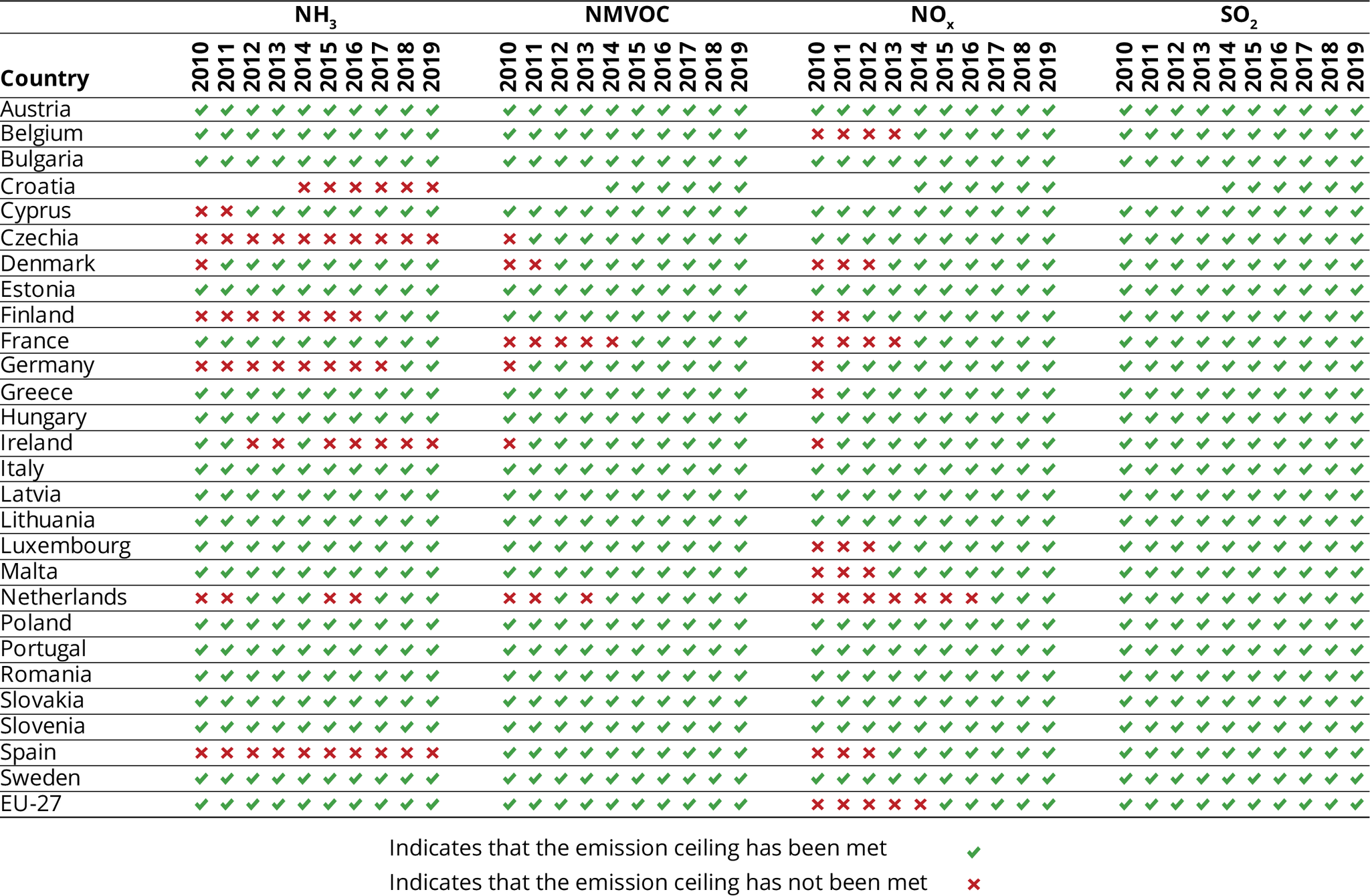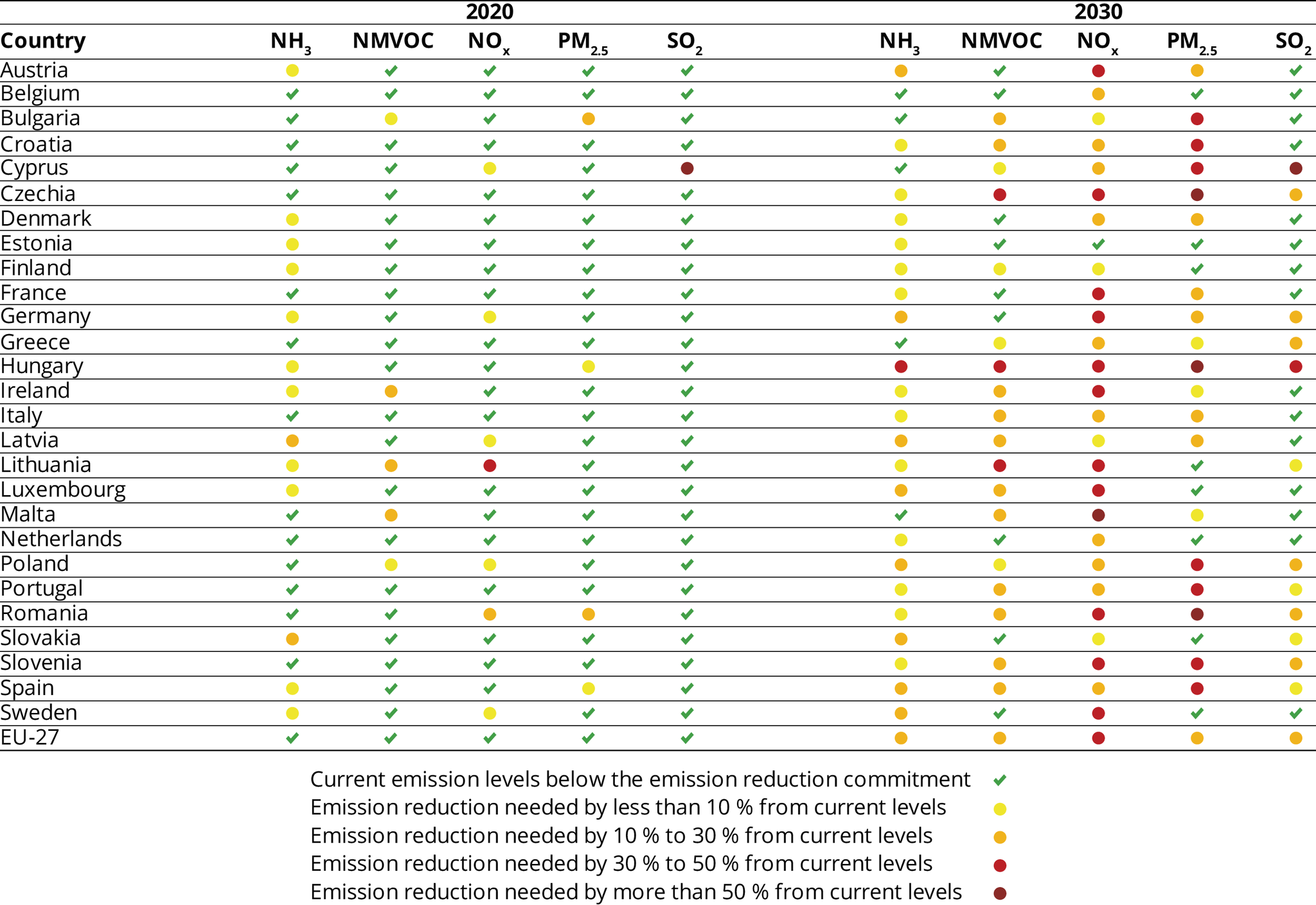Comparing Member States’ emissions with the NEC Directive 2010 emission ceilings
Air pollution continues to be one of the major challenges Europe faces, harming human health and the environment. In 2018, around 379 000 premature deaths were associated with exposure to fine particulate matter (PM2.5) alone in the EU-27 and the UK (EEA, 2020a).
Air pollution causes serious health problems, such as heart and lung disease, asthma and respiratory problems, which are a significant burden on healthcare systems. Air pollution also results in the eutrophication and acidification of ecosystems and reduces vegetation growth, including agricultural yields, through damages caused by ground level ozone. In addition, certain air pollutants act as greenhouse gases and drive climate change.
In 2019, all Member States complied with 2010 emission ceilings for NMVOCs, NOx and SO2.
NH3 emissions stopped increasing after five consecutive years of increasing emission levels (2013-2017).
In 2019, four Member States had NH3 emissions higher than their 2010 ceilings.
The 2016 NEC Directive (Directive (EU) 2016/2284) ensured that the emission ceilings for 2010 (established under the 2001 Directive on national emission ceilings) remained applicable until the end of 2019 (EU, 2016).
New emission reduction commitments now apply for the period 2020-2029, and more stringent commitments apply for 2030 onwards. Under the 2016 NEC Directive, Member States report annual emission inventory information from 1990 — or in the case of PM2.5 from 2000 — for 2 years before the present year.
The analysis presented here is based on the latest air pollutant emission inventory data for the period 2010-2019, as reported by Member States in February 2021. The briefing also provides an assessment of the emission reductions required if Member States are to meet their reduction commitments for 2020-2029 and 2030 onwards, compared with their 2019 emission levels[2].
Emission levels for the four key air pollutants (NH3, NMVOCs, NOx and SO2) for the EU as a whole have been well below the emission ceilings since 2012.
Table 1 provides an overview of Member States respecting and failing to respect the 2010 emission ceilings for four key pollutants over the period 2010-2019. The NEC Directive does not include a 2010-2019 ceiling for PM2.5.
25 Member States reduced their PM2.5 emissions between 2018 and 2019.

More info
The compliance check against current emission ceilings takes into account adjustment applications approved by the European Commission in 2020. New adjustment applications submitted in 2021 are not taken into account (see Box 1). All adjustment applications will be reviewed by the Commission. If approved, the number of Member States exceeding one or more emission ceilings could change. Resubmissions of adjustment applications approved in previous years and reported by 5 June 2021 are considered accepted for this exercise.
The assessment of the EU’s progress towards the 2010 NEC Directive emission ceiling is made for the EU-27 and the UK. However, as the United Kingdom no longer reports data on emissions to the EEA under the NEC Directive, the table does not include UK data.
Box 1. ‘Adjustments’ to emission inventories under the National Emission reduction Commitments Directive
Consistent with a similar procedure agreed by the parties to the Gothenburg Protocol of the Convention on Long-range Transboundary Air Pollution, the National Emission reduction Commitments Directive (Article 5) establishes a process that allows Member States to ‘adjust’ their emission inventories downwards for compliance checking. The process applies if failure to comply with the national ceilings is caused by Member States having applied emission inventory methods that have been updated in accordance with new scientific knowledge available since the 2010 ceilings were originally set.
Member States wishing to adjust their data in this way must first notify the European Commission (by 15 February each year) and subsequently submit a range of documentation (by 15 March each year) for review.
Adjustment applications for sub-sectors and pollutants that were approved by the Commission in 2020 are taken into account in the present briefing, so that it is possible to identify whether or not ceilings have been respected. However, new adjustment applications submitted in 2021 are currently under evaluation and are not taken into account here. The number of ceilings exceeded by Member States stated here may, therefore, still be subject to change.
Ammonia
Four Member States, namely Croatia, Czechia, Ireland and Spain, exceeded their ammonia (NH3) ceilings in 2019. The highest percentage exceedances were reported for Spain (33 %) and Croatia (23 %). Germany was the largest emitter of NH3, followed by France and Spain.
EU emissions of NH3 have fallen by 8 % since 2005. Between 2018 and 2019, 23 EU Member States reported emission reductions for NH3. This translated into an overall reduction in EU emissions of 2 %.
Non-methane volatile organic compounds (NMVOCs)
In 2019, all 27 Member States respected their national emission reduction commitments for non-methane volatile organic compounds (NMVOCs). France was the largest emitter of NMVOCs in 2019, followed by Italy and Germany.
EU emissions of NMVOCs have fallen by 29 % since 2005. Following a small increase of around 1 % from 2016 to 2017, emissions fell by 3.4 % from 2017 to 2019.
Nitrogen oxides
Since 2016, all Member States have been in compliance with their nitrogen oxide (NOx) emission ceilings. In absolute terms, Germany was the largest emitter of NOx in 2019, followed by France and Poland.
For the EU as a whole, the emission reduction compared with 2005 levels is about 42 %, with a reduction of about 5 % between 2018 and 2019.
Sulphur dioxide (SO2)
In 2019, all Member States were in compliance with their emission ceilings for sulphur dioxide (SO2). Poland was the largest emitter of SO2, followed by Germany and Spain.
EU emissions of SO2 have fallen by 77 % since 2005. From 2018 to 2019, almost all Member States (24 out of 27) reported emission reductions, translating into an aggregate reduction of 11 % for the EU as a whole.
Fine particulate matter
The NEC Directive does not include a 2010 ceiling for PM2.5. Italy was the largest emitter of PM2.5 in 2019, followed by France and Poland.
EU emissions of PM2.5 have fallen by 29 % since 2005. From 2018 to 2019, 25 Member States reported reduced emissions of PM2.5, delivering an overall EU reduction of 2 %.
Further effort needed to meet national emission reduction commitments for 2020-2029 and 2030 onwards
The 2010-2019 emission ceilings applied until the end of 2019 in line with the NEC Directive. The collective efforts of Member States have resulted in total EU emissions of the four regulated pollutants (NOx, NMVOC, NH3 and SO2) being well below their respective ceilings for every year since 2012.

Further action is required by Member States if they are to meet their 2030 emission reduction commitments.
Photo by Ivan Bandura on Unsplash
Nevertheless, further efforts will be required to reach the more ambitious emission reduction commitments set for the period 2020-2029, and the yet more stringent 2030 commitments. Table 2 shows the percentage reductions compared with 2019 emission levels[3] that will be required if Member States are to reach their 2020-2029 and 2030 emission reduction commitments. The required emission reduction is calculated as the percentage difference between 2019 reported emissions and the emission reduction commitments for 2020-2029 and for 2030 onwards.
Countries are divided into five groups:
- countries where current emission levels are below the emission reduction commitment
- countries that need to reduce emissions by less than 10 %
- countries that need to reduce emissions by 10 to less than 30 %
- countries that need to reduce emissions by 30 to less than 50 %
- countries that need to reduce emissions by more than 50 %.
As shown in Table 2, emission levels in 2019 show that 9 EU Member States have already achieved the emission reduction commitments set for the period 2020-2029 for all five key pollutants. This is supported by the results of an analysis of projected emissions reported by Member States in 2019 (EC, 2020a).
need to reduce NOx emissions by more than 30 %
have to halve
their PM2.5 emissions
For the remaining Member States, meeting the emission reduction commitments for NH3, NOx, NMVOC and PM2.5 presents significant challenges when 2019 emissions are compared against the 2020-2029 commitments. As regards 2020 data, the lockdown measures implemented across Europe to reduce the transmission of COVID-19 and the subsequent reduced economic activity in 2020 can be expected to have had an impact on emissions of some pollutants. In particular, air quality data reported by EEA member countries demonstrate that concentrations of NO2 — a pollutant mainly emitted by road transport — decreased in many European cities during periods of lockdown (EEA, 2020b).
Nitrogen oxides
Lithuania and Romania need to deliver NOx emission reductions of more than 10 % compared with 2019 levels to reach their 2020-2029 emission reduction commitment. An additional five countries need to reduce emissions by up to 10 %. Significant declines in road traffic levels in 2020 due to the COVID-19 lockdowns may facilitate the attainment of these commitments for 2020, but this is likely to be a short-term effect only.
Fine particulate matter
Bulgaria and Romania need to reduce PM2.5 emissions by more than 10 % compared with 2019 levels to reach their 2020-2029 emission reduction commitment. Spain and Hungary need to reduce their emissions by up to 10 %.
The impact of the lockdown measures on PM2.5 emissions is more complex than for NOx. While emissions from traffic fell, in some regions, there may have been an increase in PM2.5 emissions from domestic combustion of coal or wood, as people had to stay at home. Agricultural emissions of PM2.5 were probably not affected by the lockdown, while in some areas industrial emissions are expected to have fallen (EEA, 2020a).
Ammonia
Latvia and Slovakia need to reduce emissions by more than 10 % against 2019 levels to attain their 2020-2029 emission reduction commitments. Eleven Member States need to reduce NH3 emissions by up to 10 %. This is significant, as in many countries NH3 emissions have decreased only slightly, or in some cases increased, since 2005. The principal source of NH3 emissions is agriculture, a sector less affected by the COVID-19 lockdown restrictions.
Non-methane volatile organic compounds
Five Member States need to reduce their NMVOC emissions. Bulgaria and Poland need to reduce them by less than 10 %, while Ireland, Lithuania and Malta need to reduce them by between 10 % and 30 %.
Sulphur dioxide
All but one Member State are expected to fulfil their 2020-2029 commitments for SO2. In Cyprus, SO2 emissions need to be reduced by more than 50 %.

More info
The effective implementation of the NEC Directive will be key to reaching the zero pollution goal of the European Green Deal
The path to achieving a zero pollution Europe
Effective implementation of the NEC Directive is crucial to achieving the goal of the zero pollution action plan (EC, 2021a), which sets the target of reducing the number of premature deaths associated with air pollution by 55 % by 2030 compared with 2005 levels. To achieve this target, it will be vital that EU Member States meet the emission reduction commitments set for 2020-2029 and for 2030 onwards.
Looking to 2030 and beyond, a continuous focus on reducing emissions is required. All Member States need to lower 2019 emission levels for at least one pollutant. The greatest challenges are reducing emissions of NH3, NOx and PM2.5.
- Reducing NH3 emissions will continue to be a major challenge. Almost all Member States need to lower emissions to reach their 2030 commitments, and nine Member States need to lower emissions by more than 10 %.
- All Member States except Estonia need to reduce NOx emissions. For many countries the required decrease is significant, with 10 countries requiring reductions of more than 30 % and Malta a reduction of more than 50 %.
- The majority of countries (19) need to take action to reduce PM2.5 emissions. Three Member States (Czechia, Hungary and Romania) need to reduce PM2.5 emissions by more than 50 %, while an additional seven Member States need to reduce emissions by more than 30 %.
- The picture for SO2 emissions is more positive. Fifteen Member States have already achieved their 2030 reduction commitment. Challenges remain for Cyprus, facing a required reduction of more than 50 % compared with 2019 levels, and for Hungary, which needs to reduce emission levels by more than 30 %.
- Nine Member States have already met their 2030 reduction commitments for NMVOC emissions, while Czechia, Hungary and Lithuania need to reduce emission levels by more than 30 %.
Effective and strong policies in the energy, industrial, transport and agricultural sectors are essential to ensure that 2030 reduction commitments are met
In its Second clean air outlook report (EC, 2021b), the Commission concluded that the measures Member States announced in their national air pollution control programmes will not be enough to reduce NH3 emissions to the extent needed to meet the 2030 reduction commitments. NH3 contributes to the formation of PM2.5, the main air pollutant driving premature death and disease. In terms of action to reduce emissions of NH3, the focus will fall on the agricultural sector, in particular on good practice for housing and feeding livestock, storing manure, and spreading manure and fertiliser.
The road transport sector is largely responsible for emissions of NOx, while internal combustion engines and brake wear in both conventional and electric vehicles are also sources of PM2.5. Changes in the energy sector will also be crucial for meeting the 2030 reduction commitments for PM2.5, as burning wood and coal for residential heating still contribute significantly to emissions. Actions to reduce emissions include switching fuel types, installing low-emission boilers, improving insulation and upgrading heating systems.
Regarding emissions from industry, the Commission is currently revising EU rules on industrial emissions, recognising that new technologies or production processes may reduce emissions of both key air pollutants and greenhouse gases.
The proposal for the first European Climate Law (EC, 2020b) aims to achieve net zero emissions of greenhouse gases, by cutting greenhouse gas emissions, investing in green technologies and protecting the natural environment. Ensuring consistency between Member States’ national energy and climate plans and their national air pollution control programmes can increase the reduction in emissions of both air pollutants and greenhouse gases across the energy, industrial, transport and agricultural sectors.
Notes
[1] Following the United Kingdom’s withdrawal from the EU, it no longer reports data on emissions to the EEA under the National Emission reduction Commitments (NEC) Directive. The assessment therefore considers the reporting status of the 27 EU Member States and excludes the United Kingdom.
[2] Croatia joined the EU in mid-2013, so for the years 2010-2013, Croatia’s emissions and ceilings are not considered.
[3] Compliance rules relating to the reduction commitments are taken into account: emissions from sectors 3B (manure management) and 3D (agricultural soils) are not included in NOx and NMVOC emissions; for those countries allowed to use ‘transport fuel used’ emissions for compliance, these emissions have been taken into account. (This applies to Austria, Belgium, Ireland, Lithuania, Luxembourg and the Netherlands, According to their respective national air pollution control programmes, Austria and Luxembourg have decided to use emissions based on fuel sold for compliance checking against the emission reduction commitments; their emissions have therefore been treated accordingly.) Adjustment applications have not been taken into account.
References
EEA, 2020a, Air quality in Europe — 2020 report.
EU, 2016, Directive (EU) 2016/2284 of the European Parliament and of the Council of 14 December 2016 on the reduction of national emissions of certain atmospheric pollutants, amending Directive 2003/35/EC and repealing Directive 2001/81/EC.
EC, 2020a, European Commission report to the European Parliament and the Council on the progress made on the implementation of Directive (EU) 2016/2284 on the reduction of national emissions of certain atmospheric pollutants.
EEA, 2020b, Air quality and COVID-19.
EC, 2021a, European Commission Zero pollution action plan: Towards zero pollution for air, water and soil.
EC, 2021b, European Commission Second clean air outlook report.
EC, 2020b, European Commission Proposal for a European Climate Law.
Identifiers
Briefing no. 06/2021
Title: National Emission reduction Commitments Directive reporting status 2021
HTML - TH-AM-21-006-EN-Q - ISBN 978-92-9480-381-8 - ISSN 2467-3196 - doi: 10.2800/064525
PDF - TH-AM-21-006-EN-N - ISBN 978-92-9480-382-5 - ISSN 2467-3196 - doi: 10.2800/609015
The European Environment Agency (EEA) is an agency of the European Union. The EEA aims to support sustainable development and to help achieve significant and measurable improvement in Europe’s environment, through the provision of timely, targeted, relevant and reliable information to policymaking agents and the public. For more information, visit: eea.europa.eu.
© European Environment Agency, 2021
Sign up to receive EEA reports in your area of interest (print and/or electronic) and quarterly e-newsletter: http://eea-subscriptions.eu/subscribe
Following the United Kingdom’s withdrawal from the EU, it no longer reports data on emissions to the EEA under the National Emission reduction Commitments (NEC) Directive. The assessment therefore considers the reporting status of the 27 EU Member States and excludes the United Kingdom.


Document Actions
Share with others